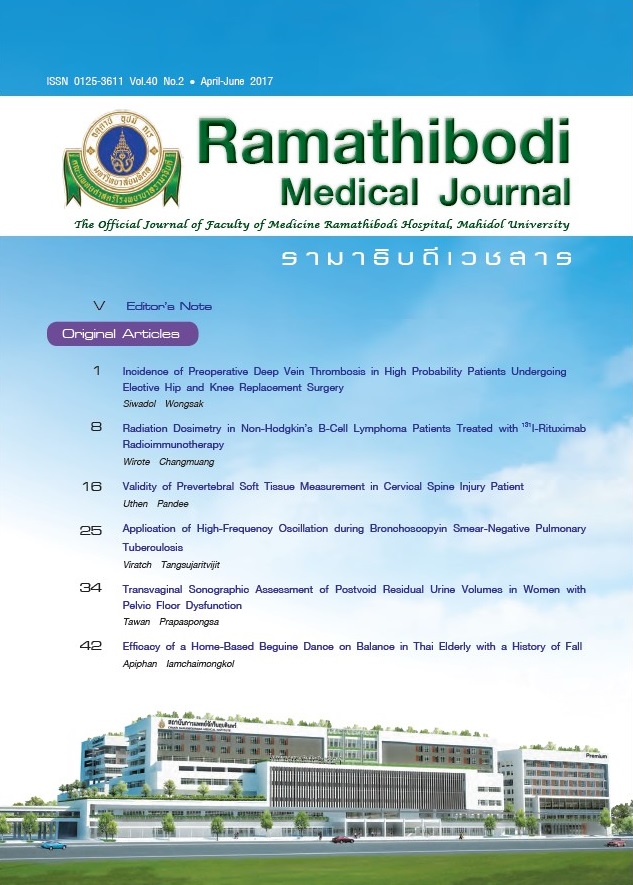Validity of Prevertebral Soft Tissue Measurement in Cervical Spine Injury Patient
Main Article Content
Abstract
Background: Cervical radiographs were the initial screening in patients who present with blunt cervical spine (C-spine) injury. The cervical prevertebral soft tissue measurement generally used as screening test in Emergency Department (ED). Many criterias were mentioned in the literatures but the comparison of the validity of the measurements wasn’t concluded.
Objective: To compare validity of cervical prevertebral soft tissue measurement criteria in C-spine injury patients.
Methods: Retrospective reviewed of cervical radiographs measurement patient who suspected C-spine injury from January 2005 to August 2011. The prevertebral soft tissue thickness were measure from C2 to C7 according to criteria from literatures then compared with the final diagnosis by computerize tomography (CT) scan. The results were applied for validation of the criteria.
Results: There were 127 patients in this study. Ninety four (74%) were male. Fifty six (44.1%) patients had c-spine fracture in final diagnosis. The measurement criteria of prevertebral soft tissue C3 > 5 mm, showed the most valid predictability tool, by specificity 73%, sensitivity 49% and area under the receiver operating characteristics (AOC) curve was 0.72 respectively.
Conclusion: Measurement of prevertebral soft tissue has fair ability to detect C-spine injury. Our study suggests the criteria of C3 prevertebral soft tissue > 5 mm has high sensitivity and may be consider to be used as screening test. However, patients whom c-spine injury are suspected should have further investigation especially CT-scan to finalize diagnosis.
Article Details
References
Hoffman JR, Mower WR, Wolfson AB, Todd KH, Zucker MI. Validity of a set of clinical criteria to rule out injury to the cervical spine in patients with blunt trauma. National Emergency X-Radiography Utilization Study Group. N Engl J Med. 2000;343(2):94-99.
Grossman MD, Reilly PM, Gillet D. National survey of the incidence of cervical spine injury and approach to cervical spine clearance in U.S. trauma centers. J Trauma. 1999;47(4):684-690.
Gerrelts BD, Petersen EU, Mabry J, Peterson SR. Delayed diagnosis of cervical spine injuries. J Trauma. 1991;31(12):1622-1626.
Davis JW, Phreaner DL, Hoyt DB, Mackersie RC. The etiology of missed cervical spine injuries. J Trauma. 1993;34(3):342-346.
Diaz JJ Jr, Gillman C, Morris JA, Jr, May AK, Carrilo YM, Guy J. Are five viewed plain films of the cervical spine unreliable ? A prospective evaluation in blunt trauma patients with alter mental status. J Trauma. 2003;55(4):658-63.
Holmes JF, Akkinepalli R. Computed Tomography Versus Plain Radiography to Screen for Cervical Spine Injury: A Meta-Analysis. J Trauma. 2005;58(5):902-905.
Barba CA, Taggert J, Morgan AS, et al. A new cervical spine clearance protocol using computed tomography. J trauma. 2001;51(4):652-656.
Blackmore CC, Ramsey SD, MannFA, Deyo RA. Cervical spine screening with CT in trauma patients: a cost-effectiveness analysis. Radiology 1999;212(1):117-125.
Doris PE, Wilson RA. The next logical step in the emergency radiographic evaluation of cervical spine trauma: the five-view trauma series. J Emerg Med. 1985;3(5):371-385.
Insko EK, Gracias VH, Gupta R, Goettler CE, Gaieski DF, Dalinka MK. Utility of flexion and extension radiographs of the cervical spine in the acute evaluation of blunt trauma. J Trauma. 2002;53(3):426-429.
Paakkala T. Prevertebral soft tissue changes in cervical spine injury. Crit Rev Diagn Imaging. 1985;24(3):201-236.
Miles KA, Finley D. Is prevertebral soft tissue swelling a useful sign in injury of the cervical spine? Injury. 1988;19(3):177-179.
Herr CH, Ball PA, Sargent SK, Quinton HB. Sensitivity of Prevertebral Soft Tissue Measurement at C3 for Detection of Cervical Spine Fractures and Dislocations. Am J Emerg Med. 1998;16(4):346-349.
Dai, LY. Significance of prevertebral soft tissue measurement in cervical spine injury. Eur J Radiol. 2004;51(1):73-76.
Baron BJ, Mcsherry KJ, Larson JL, Scalea TM. Spine and spinal cord trauma. In: Tintinalli J, ed. Emergency medicine a comprehensive study guide. 7th ed. New York, NY: McGraw-Hill; 2011:1709-1730.
Hockberger RS, Kaji AH, Newton E. Spinal injuries. In: Marx JA, ed. Ronsen’s emergency medicine concepts and clinical practice. 7th ed. Philadelphia, PA: Elsevier Saunders; 2010:337-375.
American College of Surgeons Committee on Trauma. Advanced trauma life support for doctors. 8th ed. Chicago: American College of Surgeons; 2008:157-186.
Wood GW. Cervical spine injury. In: Canale ST, ed. Campbell’s operative orthopaedics. 11th ed. Philadelphia, PA: Elsevier Saunders; 2007:1761-1804.
